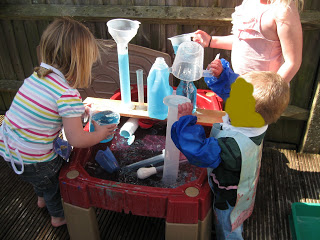It occured to me last week as I again found that wet tissue paper had stained my floor (must position something over it before hubbie spots it) that maybe I could use it to dye the water in the water tray. So we tried this yesterday and bingo, pink water (and pink hands!). I put one sheet of tissue paper into the water, swished it around, squeezed it (hence the pink hands) and used a sieve to get out the little bits as it fell apart. It didn’t dye the children’s hands thankfully, I was wondering how I was going to explain that one to the parents. I’m not sure about clothes though, I’ll let you know if I get any complaints!
It was such a success that we went for turquoise today (I will remember to wear gloves next time).
 |
I also tried dying the water with crepe paper, but unfortunately they must make it colour fast now.
Again thanks to tomsensori who was my inspiration for putting planks across the water table. I usually position a table at the end, but this worked so much better. The children did not have to move from where they were playing and made full use of them. I’m on the look-out for something longer that I can put along the centre of the table now, preferrably with sides to contain the water.
As the children played, I noticed one little boy seemed fascinated with putting his hands under the water as the other children tipped up the containers. I remembered I had some large plastic cups, so used a heated a screwdriver on the cooker and melted holes into them in various patterns.









